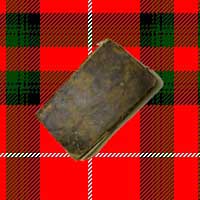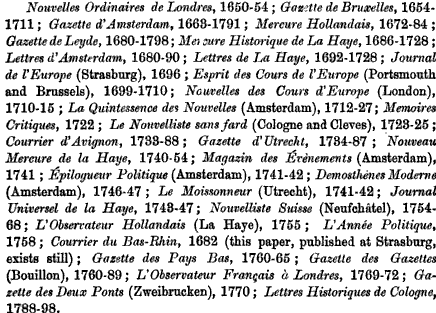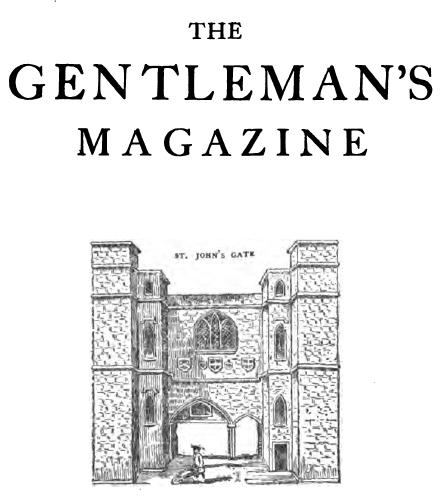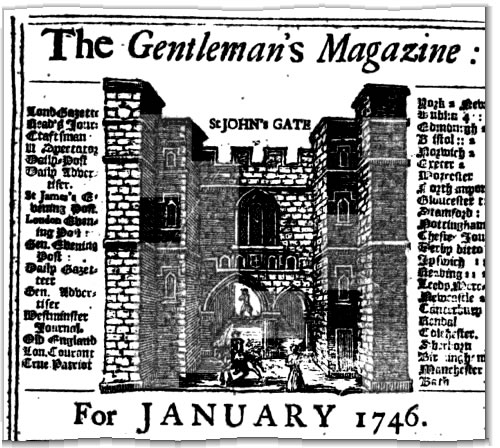
home
| Newspapers during the 1745-6 rebellion |
The newspapers were the main source of information for the general public such as (in London) the London Gazette, the General Advertiser, the Daily Advertiser, the Daily Post, the General Evening Post, the London Courant, Lloyd’s Evening Post, the Whitehall Evening Post, the British Chronicle, the London Evening Post, the True Patriot, and the St. James’ Chronicle or British Evening Post. In other parts of the country the Newcastle Courant, the Edinburgh Courant, the Caledonian Mercury, the York Courant, the Derby Mercury, Many of these are available through the British Library's Burney Collection. Another online source on early English provincial newspapers is Freshest Advices by R.M. Wiles. ‘This Method of Weekly Publication allures
|
| London Gazette |
The official government notices (Published by Authority) can be found in the archives of the London Gazette for example:
|
| Newcastle Courant |
Stories from the Newcastle Courant include the battle plan of Culloden moor. These original newspapers can be read and photographed at Newcastle City Library's Local Studies. This book contains articles from the Courant An old story re-told from the 'Newcastle courant'. The rebellion of 1745. |
| Edinburgh Courant |
The first issue of the Edinburgh Courant was dated Feb 14-19, 1705 and was sold for a penny. It was one of the country's first regional papers, second only to the Norwich Post (1701). The paper was produced twice weekly for five years, then continued as the Scots Courant until April 1720. Later that same year, the Edinburgh Evening Courant began publication, and it survived until the Evening News came into existence in 1873. Original copies of the Edinburgh Courant can be read at the National Library of Scotland (see the link in the catalogue). |
| Caledonian Mercury |
1720. — Caledonian Mercury. First established by William Holland, an Edinburgh lawyer, this paper in 1729 came into the hands of Thomas Ruddiman, the Latin grammarian and publisher. It claimed to be the successor of the early ‘Mercurius Caledonius,’ though perhaps for no better reasons than the express coincidence of title and the partiality to the house of Stuart, which is supposed to have influenced its promoters. Three times a week. Original copies of the Caledonian Mercury can be read at the National Library of Scotland (see the link in the catalogue). |
| General Advertiser |
London |
| Grub Street Journal | ||
London On Thursday, January 8th, 1730, the reading public of London was offered the first number of the Grub-street Journal. The new paper consisted of a small folio of four pages. At its head was the information that it was “to be continued weekly,” and beneath, four significant lines from The Dunciad, Book I. Although this publication had ceased to exist in 1737, its importance ensured a place in history. Here are the issues from March 12, 1730 and (the article on the [apparent] death of Mr. Bolt was typical of many publications of that era and copied from The Daily Courant.) January 27, 1737; Issue 370. |
||
| Norwich Post | ||
The first of the provincial newspapers to be established in the eighteenth century, the Norwich Post, had numerous advertisements, every surviving issue for 1708 and 1709 having seventeen or more, the offerings ranging from "very good Cart Greece" to "14 couple of good seized and well manag'd Beagles." One of the unusual opportunities advertised as available to Norwich people is announced in number 413 (23 July 1709) of the Norwich Post:
|
| Gazette de France |
This was published in Paris from 1631. Here is the copy for November 1745. |
| Mercure de France |
The Mercure de France was published in France 1672-1674. Here is the issue for January 1746. |
| Courrier d'Avignon |
The Courrier d'Avignon was published in France 1733-1778. Here is page 3 of October 1, 1745 announcing Prince Charles' near Fort William. This newspaper, dated December 31, 1745 from Paris (on p. 4), shows that the French and the Duke of York were still making plans to support Charles on 13th December (December 24th N.S.), |
| French Language newspapers vs. the King |
This article followed on from the First Period in June 1873 of The Cornhill Magazine (Volume 27), in 1874 the third and fourth period were published and followed up ten years later. As may be supposed a king so autocratic as Louis XIV did not relent in his severity towards the Press from any growing love of journalism he yielded because the Press was simply too strong for him. The papers which were published abroad and found their way into France were most dangerous nuisances. They undermined the royal authority by lauding the institutions of free states like England and Holland and they turned the King personally into ridicule by painting him exactly as he was in mind body and speech. Louis XIV has come down to us like many another sovereign with the halo of grandeur which Court panegyrists and historians have set like a second crown on his head lint kings are not as a rule famous for great intellect or even for common sense or taste and Louis XIV was as Thackeray has so well dubbed him a Royal Snob Eaten up by his own conceit talking an inflated jargon of bumptiousness pompous in little things peevish dissolute ugly and hypocritical he was just the king to afford humorists an endless subject for jokes and his successor Louis XV was like him with the additional royal virtue of being stingy. The Gazette d'Amsterdam and the Gazette de Leyde, two papers which are better known under the generic title of the Gazette de Hollande (There was never a paper called the Gazette de Hollande. The name was collectively to all the French Gazettes printed on Dutch territory for circulation in France) took minute note of all the foibles and stupid utterances of this kingly pair. They had correspondents at Court who could never be detected (the Duke de Saint Simon was always suspected of being one of them; hence Louis XIV's strong dislike to him; the Due de Lauzun was suspected too) and they led a mocking chorus which was kept up by a multitude of other gazettes some of which were virulent beyond conception. Here is a complete list of the foreign papers printed in French which made sport of the Majesties of Louis XIV and XV and soured their royal minds:- Other French language newspapers of the time are Nouvelles Ordinaire de Londres, 1650-54; Gazette de Bruxelles, 1654-1711; Gazette d'Amsterdam, 1668-1791; Mercure Hollandais, 1672-84; Gazette de Leyde, 1680-1798; Mercure Historique de La Haye, 1686-1728; Lettres d'Amsterdam, 1680-90; Lettres de La Haye, 1692-1728; Journal de l'Europe (Strasburg), 1696; Esprit des Court de l'Europe (Portsmouth and Brussels), 1699-1710; Nouvelles des Cours d'Europe (London), 1710-15; La Quintessence des Nouvelles (Amsterdam), 1712-27; Memoires Critiques, 1722; Le Nouvelliste sans fard (Cologne and Cleves), 1723-25; Courrier d'Avignon, 1738-88; Gazette d'Utrecht, 1734-87; Nouveau Mercure de la Haye, 1740-54; Magasin des Évènements (Amsterdam), 1741; Épilogueur Politique (Amsterdam), 1741-42; Demosthenes Moderne (Amsterdam), 1746-47; Le Moissonneur (Utrecht), 1741-42; Journal Universel de la Haye, 1748-47; Nouvelliste Suisse (Neufchatel), 1754-68; L'Observateur Hollandais (La Haye), 1755; L'Année Politique, 1758; Courrier du Bas-Rhin, 1682 (this paper published at Strasburg, exists still); Gazette des Pays Bas, 1760-65; Gazette des Gazettes (Bouillon), 1760-89; L'Observateur Français a Londres, 1769-72; Gazette des Deux Ponts (Zweibrucken), 1770; Lettres Historiques de Cologne, 1788-98. The Cornhill Magazine - Volume 28 - Jul-Dec 1873 That these papers were not foes to be despised may be seen from the long time which many of them lasted; and several volumes might be written about the stratagems employed for introducing them into Franco and the diverse methods adopted by the Crown to combat them. They entered France in herring tubs, in bottles presumed to contain Rhine wine, in bales of cloth, oyster barrels, boots, coat linings and even in the muzzles of cannon returning from war. Coming back to France to winter after a campaign in Flanders Marshal Vauban ordered a battery to halt and fire a salute to the French flag within sight of the frontier. Of the six pieces that were drawn up for this purpose five were found rammed to the mouth with copies of the Gazette d Amsterdam which a captain of artillery had put there "to prevent the damp from getting into the guns" as he laughingly said. Vauban appears to have laughed too though he ordered the gazettes to be torn up and distributed as wadding. The papers were, in fact, irrepressible. In vain was it that the King's ambassadors complained of them; in vain was it that Louis XIV conquered Holland, actuated in his hatred for that country principally by the Gazettes it produced: in vain was it that the importation of all foreign journals was declared high treason. The papers filtered across the frontier no one could tell how. One day Louis XIV marched into the Galère des Glaoes at Versailles livid with rage and holding a newspaper clenched in his hand. The whole Court were assembled and quaked at the signs of fury which were unusual with the King for he seldom went beyond waspishness. "Monsieur de la Reynie," he cried shrilly to the Lieutenant of Police, "this must be put a stop to. Any man, no matter what may be his rank, who is found with one of these papers in his possession shall answer for it with his head." Half an hour later drawing his handkerchief from his pocket he pulled out a Dutch Gazette which some nimble fingered courtier had dropped there, probably to show the absurdity of punishing people for what might be a mere accident. As to Louis XV and his mistresses Mdme. de Pompadour and Mdme. du Barry, they were continually discovering newspaper extracts thrust by unknown hands in places where they would be sure to find them. The Due de Richelieu talking one day of the scurrilousness of foreign journalists, Mdme. du Barry answered spitefully, "I should like to see into your heart and find how many of those scurrilous papers you had brought with you to Versailles to put into my Japan vases." " Into my heart, Madame," answered the witty Duke "you surely don't imagine your sex has left me heart enough to keep a record there of all the good things I do." On another occasion Louis XV remarked: "I wish my best friends would save themselves the trouble of putting newspapers under my napkin to prove their love for me I take their affection for granted without that." Louis XIV hit upon the idea of publishing papers in Paris which should bear the titles of Gazette de Leyde, Gazette d Amsterdam &c., hoping thereby to confuse the public, who would buy the loyal papers expecting to find treason there and be deceived for their pains. But the experiment was not of long duration—for the only people confused were the police agents, who could not be at the trouble of examining the newspaper in every reader's hand to see if it was a genuine sheet or a counterfeit. The result was, that everybody bought the disloyal gazettes and pretended, if caught, that the purchase had been made under the impression that it was the loyal print as the words cum privilegio certified. As a last resource, the licensing of Parisian gazettes under provincial names, or dating places, as above mentioned, was attempted and this was fairly successful. The République des Lettres, Bibliothèque Universelle, Journal de Médecine (half political), and Lettres Historiques are the most celebrated of the papers launched from 1682 to 1692; and in 1702-4 and 1705 appeared successively the Journal de Trévoux, Journal de Verdun, and Journal Littéraire de Blois, all three well written and highly popular. The Journal de Trévoux was edited by Jesuits and lasted many years the Journal de Verdun was conducted by a man named Claude Jordan who passed for a most devoted subject but who whilst editing a loyal paper for the King was secret editor of that very Gazette de Layde which he had been commissioned to counteract as was found out after his death to the stupefaction of all well-thinking minds. |
| The TRUE PATRIOT |
| The Champion or, The Evening Advertiser |
|
FIELDING'S 'CHAMPION' (London) AND CAPTAIN
HERCULES VINEGAR. |
| The Gentleman's Magazine |
Edward Cave, jnr., started the monthly The Gentleman's Magazine (GM) with the January 1731 issue and continued until 1907. Cave edited under the pen name of Sylvanus Urban, Gent in offices above the sixteenth-century gate of St. John's Priory in Clerkenwell, London which was displayed on the front of the magazine. Images from the first twenty volumes from 1731-1750 are online at Oxford University's Bodleian Library's collection of early journals. Because it summarized (plagiarized?) news from several sources including the London Gazette, Read's Journal, Craftsman, Spectator, Daily Post, Daily Advertiser, St.James's Evening Post, London Evening Post, General Evening Post, Daily Gazetteer, General Advertiser, Westminster Journal, Old England, London Courier, and The True Patriot as well as many provincial newspapers it is a great research resource. This is from Volume XVI for 1746. |
| The London Magazine |
The London Magazine was originally founded in 1732 as the "London Magazine, or Gentleman's Monthly Intelligencer". |


